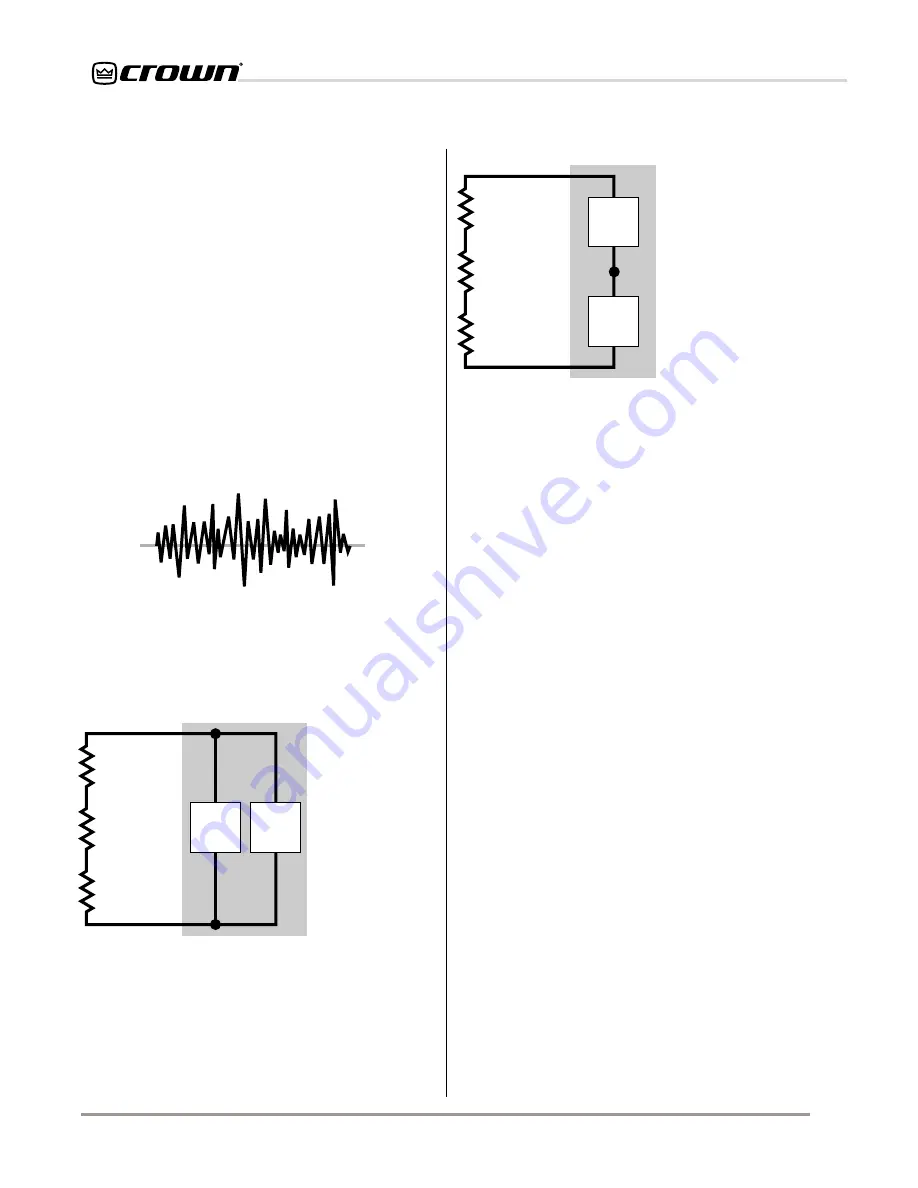
Page 22
Reference Manual
Macro-Tech
®
24x6 & 36x12 Power Amplifiers
supply becomes larger, the power transistors must dis-
sipate more heat. Also, the lower the resistance of the
power transistors, the more voltage you can deliver to
the load. But when you lower the resistance of the tran-
sistors, you increase the current passing through them,
and again increase the amount of heat they must dissi-
pate.
5.2.2 The VZ Supply
An articulated power supply like VZ avoids much of this
problem by reducing the voltage applied to the transis-
tors when less voltage is needed. Reducing the voltage
reduces the heat, so the amplifier runs cooler and more
power can be packed in safely.
The VZ supply is divided into segments to better match
the voltage and current requirements of the power tran-
sistors. Remember that audio signals like music are
complex waveforms.
When the voltage
requirements are
high, VZ supplies
switch to a
series
mode which pro-
duces higher volt-
age and less
current. The ampli-
fied output signal
never misses a beat
and gets full voltage
when it needs it—
not when it doesn’t
need it.
Fig. 5.2 Complex Musical Waveforms
For music the average level is always much less than
the peak level. This means a power supply does not
need to produce full voltage all of the time.
The VZ supply is
divided into two
parts. When the
voltage require-
ments are not
high, it operates
in a
parallel
mode to pro-
duce less volt-
age and more
current.
Fig. 5.3 VZ Supply in Parallel Mode
Fig. 5.4 VZ Supply
in Series Mode
Sensing circuitry watches the voltage of the signal to
determine when to switch VZ modes. The switching cir-
cuitry is designed to prevent audible switching distor-
tion and yield the highest possible dynamic transfer
function—you hear only the music and not the amplifier.
You get not only the maximum power with the maximum
safety, but you also get the best power matching to your
load.
5.3 Circuit Theory
Each channel is powered by its own power transformer,
T100 or T200. Both channels share TF-1, a low
voltage
transformer. The secondary outputs of each transformer
are full-wave rectified by heavy duty bridge rectifiers
and are filtered by large computer grade capacitors. A
thermal switch embedded in each transformer protects
them from overheating.
The low
voltage transformer TF-1 uses a separate fan
motor winding. The TF-1 output is rectified by diodes
D1-4, generates an unregulated 24 volts. Monolithic
regulators U1-2 provide a regulated ±15 volts.
For simplicity, the following discussion of the circuitry
and operation will refer to one channel only. Please refer
to the block diagram in Figure 5.5 and the schematics
provided at the back of this manual.
The input signal at the phone jack passes directly into
the balanced gain stage (U104-C,D). Use of a PIP mod-
ule for input signal causes the input signal to pass
through the PIP and then to the balanced gain stage.
The balanced gain stage (U104-C,D) causes balanced
to single-ended conversion to take place using a differ-
ence amplifier. From there, gain can be controlled with
a potentiometer. The error amp (U104-A) amplifies the
difference between the output signal and the input sig-
POWER
TRANSISTOR
POWER
TRANSISTOR
SPEAKER
LOAD
VZ
STAGE
+
–
VZ
STAGE
+
–
VZ POWER SUPPLY
The power transistors stay cooler and are not forced to
needlessly dissipate heat. This is the normal operating
mode of the
VZ power supply.
POWER
TRANSISTOR
POWER
TRANSISTOR
SPEAKER
LOAD
VZ
STAGE
+
–
VZ
STAGE
+
–
VZ POWER SUPPLY













































